Green Tara
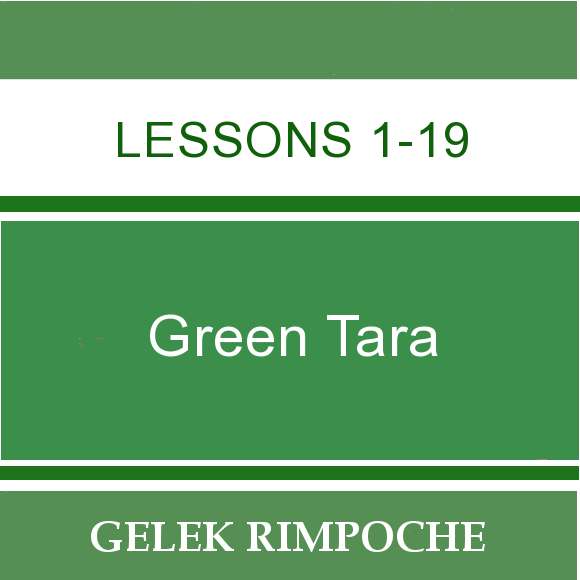
Jewel Heart Fall Retreat at Garrison 2013
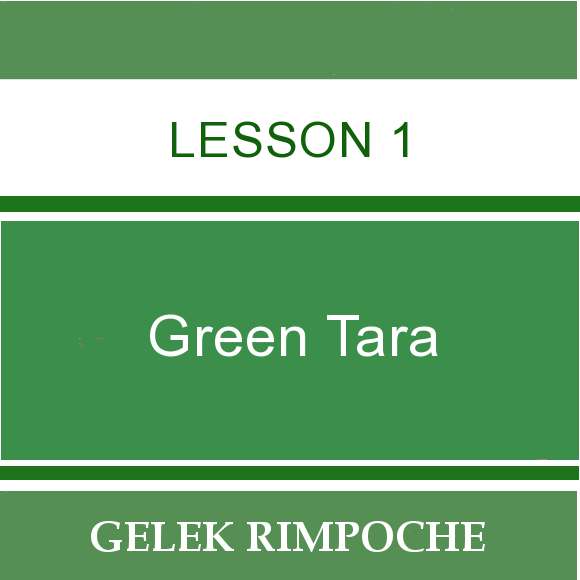
Green Tara – Lesson 1
Lesson Number 1 of 19
Rimpoche introduces Tara, and specifically the 21 Praises of Green Tara, as a time-honored practice used by generations of Tibetan monks as well as lay people of all social classes. As always, for any practice to produce desired results, motivation must be correctly understood. Motivation is the “why?” — the purpose for which we engage in Buddhist practice. If our goal is total enlightenment or Buddhahood, then Buddhism can deliver the goods. While it may be possible to achieve the ultimate goal outside of Buddha’s teachings, subtle internal obstacles including negative karma make this extremely questionable. Dharma teachings contain the tools needed to remove all samsaric obstacles. (24:45)
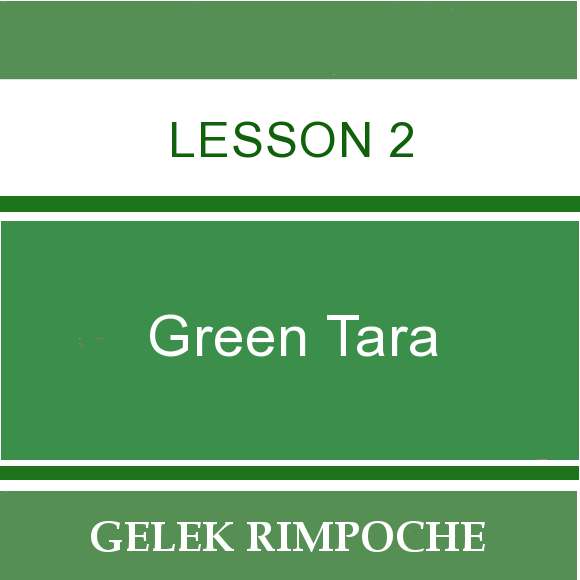
Green Tara – Lesson 2
Lesson Number 2 of 19
Stripped of its mystical aspect, Buddhism is very practical. Leaning on the experiences of a long lineage of great masters and teachers, dharma practice gradually but surely leads to the goal of total knowledge, total enlightenment. The journey may take a number of lifetimes, but the accumulated lineage of teachings provides a dependable base, a point of reference by which one can assess one’s progress. Practice requires learning, thinking and meditating. Meditation is more active than passive. It requires analytical insight to find the refined point that becomes the deeper subject of meditation. This then becomes a part of our character, our way of living and functioning — ultimately, our destiny. (24:30)
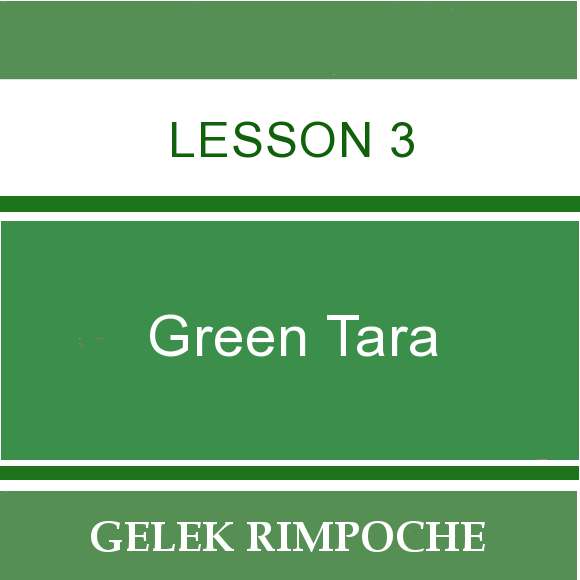
Green Tara – Lesson 3
Lesson Number 3 of 19
Responding to a question about the feminine power represented by Tara, Rimpoche notes that this is a comfortable energy, kind, forgiving and quick to function. For Buddhists Tara has the status of a female Buddha. Yet when religious and cultural curtains are lifted, she is found to be functioning in various manifestations in all parts of the world, answering the calls of those who need her assistance or protection. Buddhist practitioners are fortunate to have a number of practices focused on Tara. (10:51)
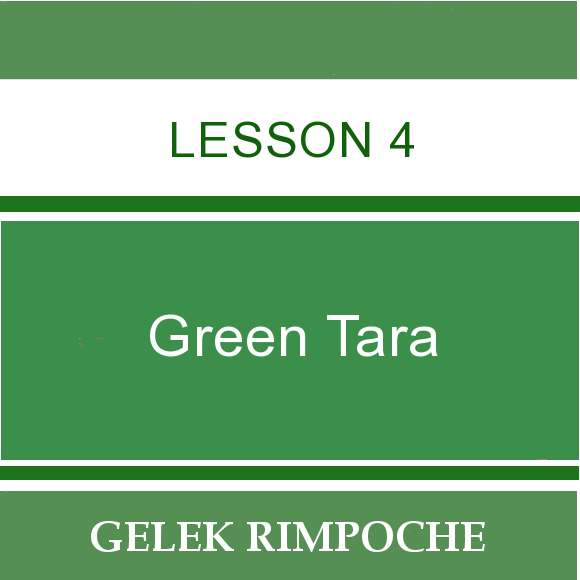
Green Tara – Lesson 4
Lesson Number 4 of 19
Having set the motivation to attain Buddhahood to be able to help all sentient beings, the question arises: What do I need to do to achieve this? Buddha’s answer is to watch and tame the mind. Our thoughts are always looking outward, seldom inward. We see everyone else’s faults, seldom our own. Dharma is like a mirror; it helps us look inward and see ourselves as we really are, both our faults and our positive aspects. With this insight, we can begin watching our mind. Particularly the “me” and “mine” deep inside the mind. So long as there is a “me” obsession at the deepest point, there is a problem for developing love, compassion and enlightenment. To recognize this and to think and meditate upon it will help us. (27:34)
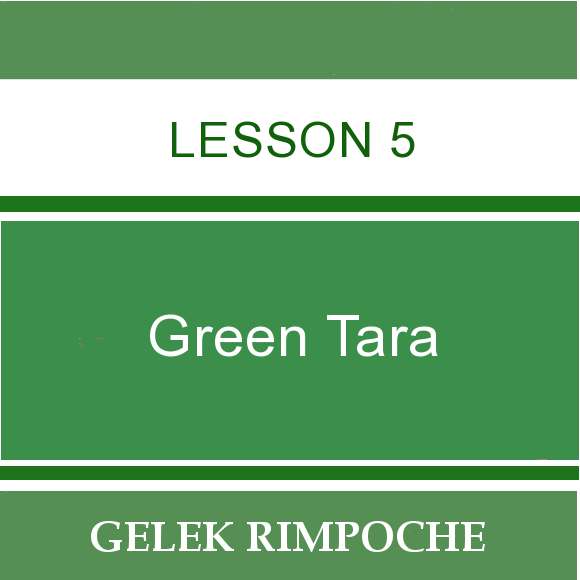
Green Tara – Lesson 5
Lesson Number 5 of 19
When we pray to Tara, to whom are we praying? At the appearance level, enlightened beings function in different and specialized ways. Yet in deepest reality they are the same: Tara is Buddha and Buddha is Tara, no separation. Ultimately, Buddhas, yidams and gurus are the same reality. It’s important to keep this in mind; when we assume separation at the deepest reality level we have a problem. In appearance, however, enlightened beings function in their distinct ways, sometimes wrathful, sometimes peaceful in nature. For our human needs, Tara manifests as the feminine aspect of Avolokitesvara, Buddha of compassion. When we invoke or invite Tara, we should know that she is already there. As with all enlightened beings, her presence is continuous and pervasive. (20:14)
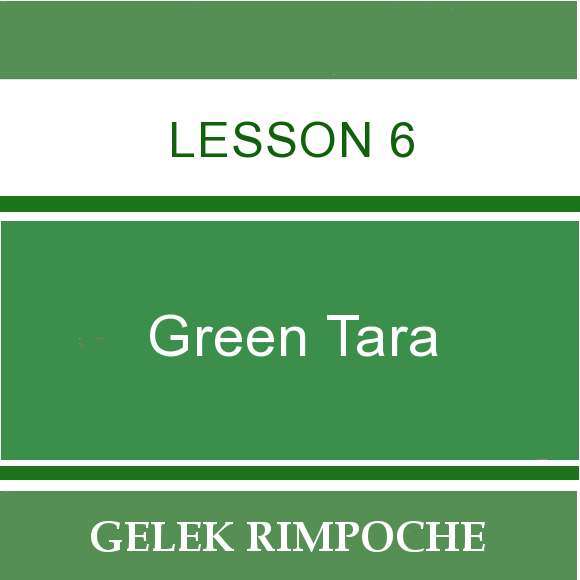
Green Tara – Lesson 6
Lesson Number 6 of 19
Green Tara resides in the turquoise-colored pure land of Yulod Kurpa. On what is this beautiful land based? On emptiness. The seed syllable of Tara’s mantra is TAM, which includes the letter “ah”, the life of all sound. Mantra is nothing but sound; it is not the written script. The essence of energy is sound and the base of sound is air, strongest of the five elements. As a seed syllable, the sound TAM is the real source of energy and power. To understand sound and energy as separate is a mistake. (20:34)
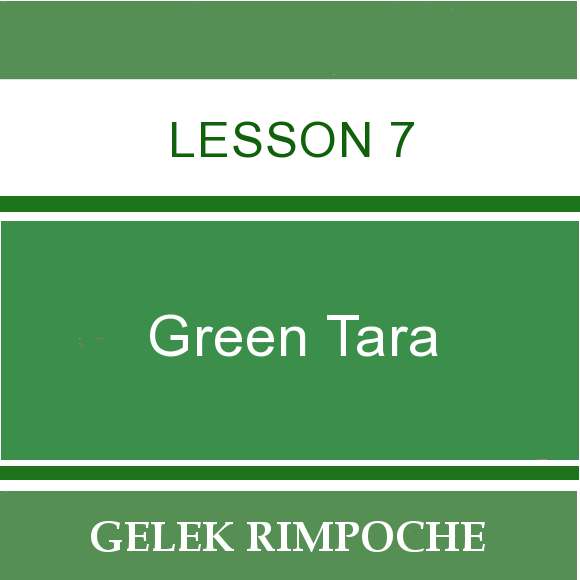
Green Tara – Lesson 7
Lesson Number 7 of 19
Tara is defined in the invocation verse of the Tara Prayers as “action mother”, indicating her role as a fully functioning Buddha, helping, protecting and healing sentient beings both directly and behind the scenes. A lot of Tara’s activity goes unseen. Prostration follows invocation, and this reflects not only our profound respect and admiration for Tara and her extraordinary qualities but also our deep wish to acquire these qualities for ourselves. (21:57)
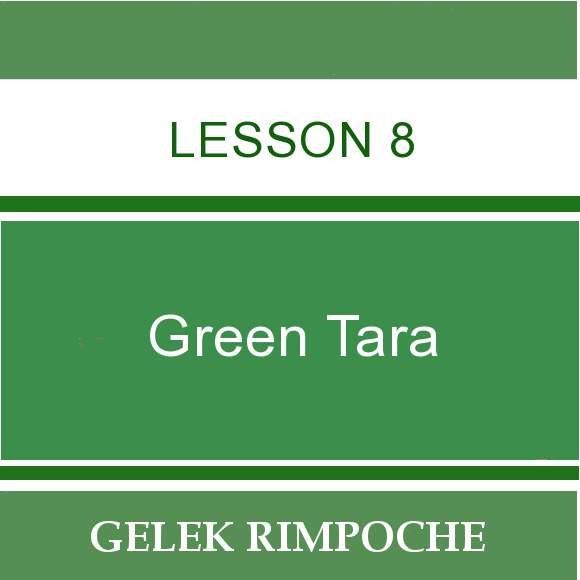
Green Tara – Lesson 8
Lesson Number 8 of 19
The main purpose of the Seven Limb activities, adapted for Tara in this practice, is to help the individual practitioner improve. Prostration, the first limb, involves looking at Tara and all other enlightened beings and, in addition to being deeply impressed by their qualities, developing a deep wish to acquire these qualities (as described in the previous section). We do this with the intention of a pure mind free from attachment. When in the next limb we make physical and mental offerings, we also think that the enlightened beings accept out offering. This provides a karmic benefit for us. (25:41)
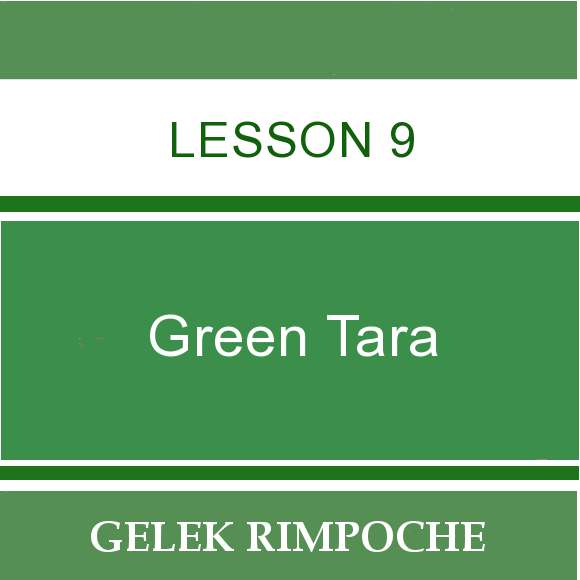
Green Tara – Lesson 9
Lesson Number 9 of 19
Purification is the third of the Seven Limbs. While karma determines that our bad actions lead to negative experiences, purification has the power to nip in the bud negative effects if they have not already begun to develop. This is because purification acts at the causal level of dependent origination. If we do not allow the negative karmic seed to develop, we may avert or ameliorate the suffering that naturally arises for us from non-virtuous actions. But for purification to succeed, we must sincerely apply the four opponent powers, the strongest of which is regret for having committed the negative action. (29:49)
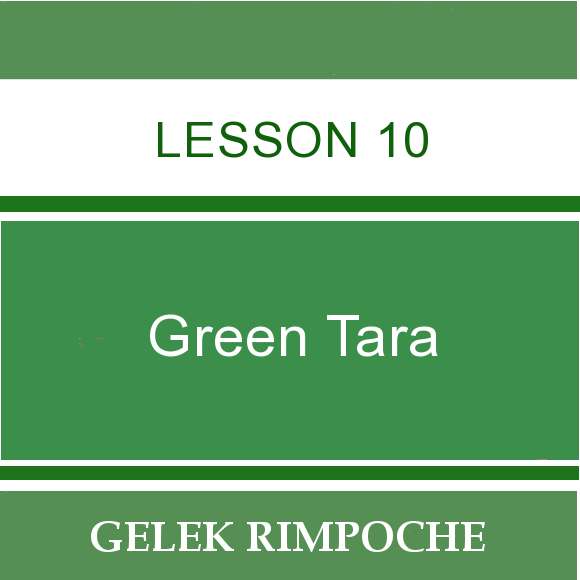
Green Tara – Lesson 10
Lesson Number 10 of 19
Rejoicing, fourth of the Seven Limbs, is an easy way to accumulate good karma. We can apply it to the people around us: when they’re doing good works and we’re rejoicing at that, we also receive karmic benefit. Rejoicing is the opposite of jealousy, an ego-grasping emotion. Rejoicing is an altruistic-based emotion. And, as Rimpoche, quips, “Rejoicing is an investment without risk.” (5:05)
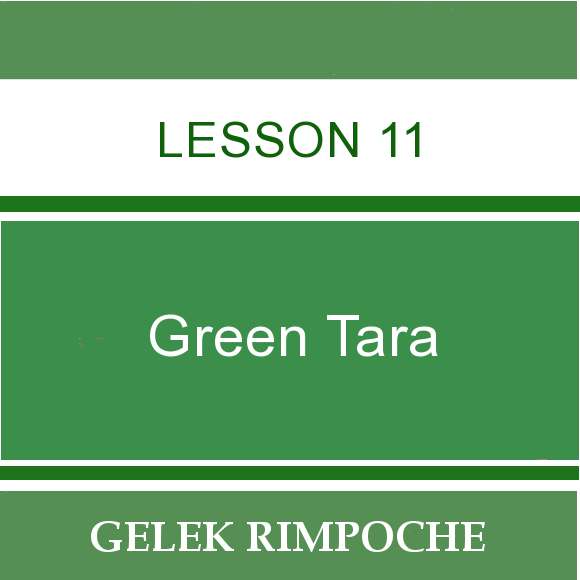
Green Tara – Lesson 11
Lesson Number 11 of 19
Request for teaching, fifth of the Seven Limbs, recognizes not only that we need teachings, but also that we need teachings suitable to the level of our mind. At times we may need basic teachings on morality, concentration and meditation, as generally reflected the Theravadin perspective. At other times, we may need teachings on the six perfections, love/compassion and bodhimind from the Mahayana scope. And at other times we may be in need of Vajrayana teachings. The request for teaching limb also reminds us of the continuing need to connect our everyday mind with the dharma so that dharma becomes part of our character and destiny. (14:44)
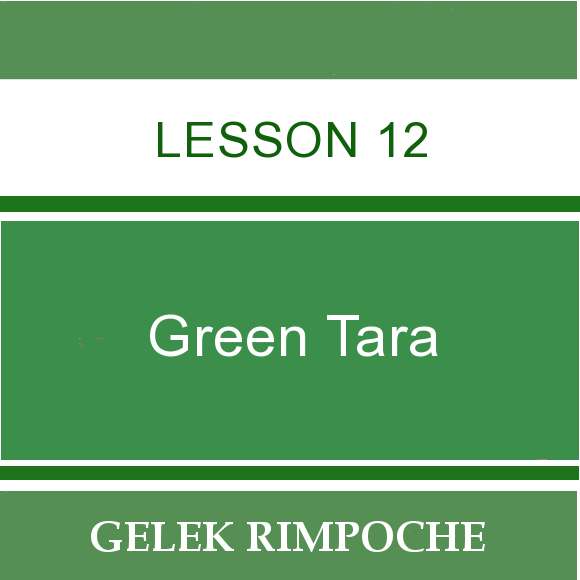
Green Tara – Lesson 12
Lesson Number 12 of 19
The final two limbs of the Seven Limp practice are a request for buddhas and dharma to remain until samsara is empty and the dedication of merit to become the cause of enlightenment for the liberation of all sentient beings. The Seven Limbs, Rimpoche says, are the simple essence practice of Buddhadharma. This should be understood not as a service to Buddha or the dharma, but a service to ourselves on the path to enlightenment. (7:32)
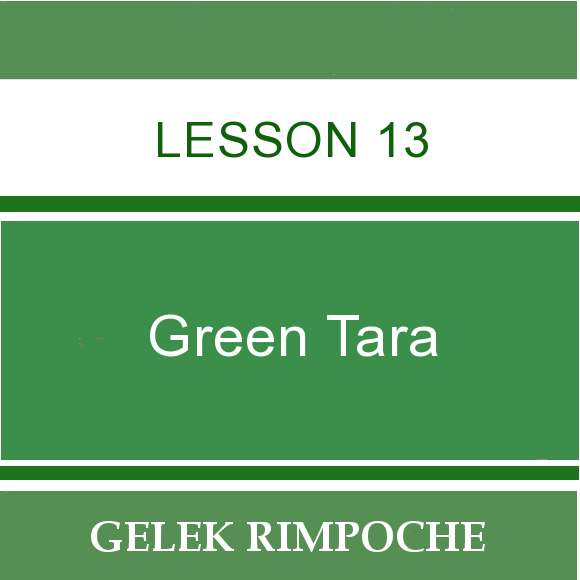
Green Tara – Lesson 13
Lesson Number 13 of 19
Rimpoche provides background to the Praises to the Twenty-one Forms of Tara, highlighting the connection of Atisha to Tara and this practice. Indeed, Tara was responsible for encouraging Atisha, through indirect means, to bring the Buddhadharma from Indian into Tibet. She appeared to Atisha many times, establishing her special commitment to followers of the Atisha tradition that continues to this day. (16:53)
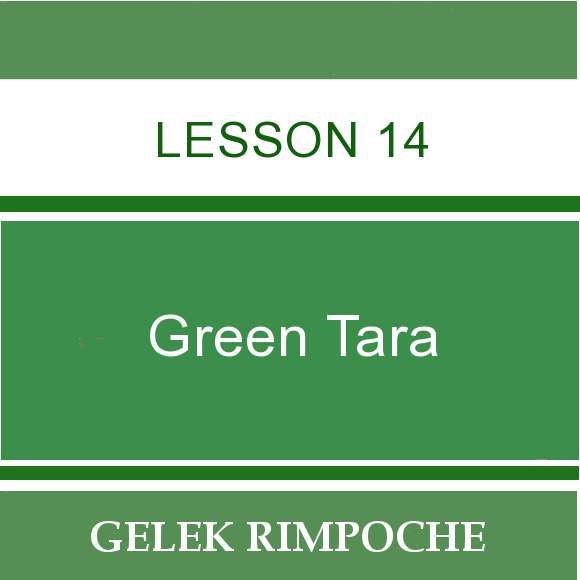
Green Tara – Lesson 14
Lesson Number 14 of 19
Rimpoche notes there are three basic ways of praising Tara: according to the historical perspective; according to Tara’s physical attributes; and according to her activities. These all relate to the extraordinary qualities of one who has gone beyond samsara and even nirvana. Tara’s name in Tibetan means liberator — one who responds with extraordinary speed and power to destroy evil forces and liberate sentient beings. Her wisdom eyes see everything immediately and simultaneously — with total knowledge. (25:12)
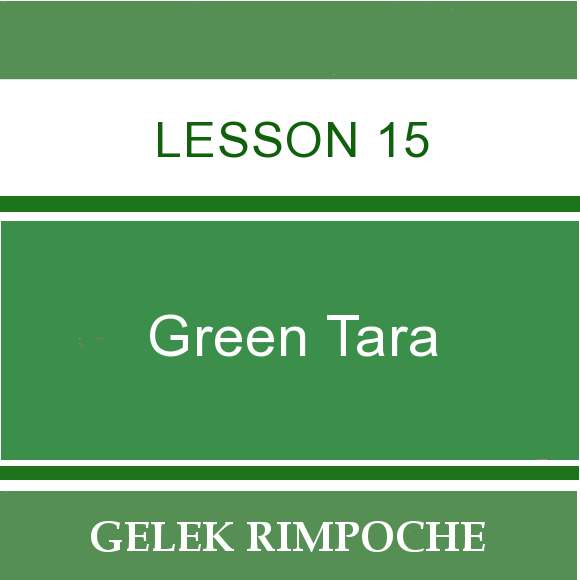
Green Tara – Lesson 15
Lesson Number 15 of 19
Tara’s face is like the visualization of 100 autumn moons. After the dust of summer, autumn is a pristine time of year in Tibet, and Tara embodies this crisp, clear and beautiful appearance. One hand gestures an invitation to come join with her, the other hand says, “I will protect you.” This invitation is for everyone, but particularly those who are downtrodden and without hope. (18:01)
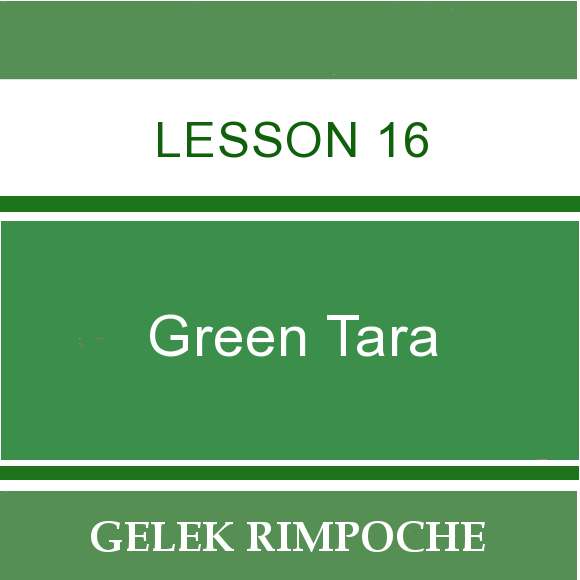
Green Tara – Lesson 16
Lesson Number 16 of 19
Tara’s capability and power comes out of the six perfections: generosity, patience, morality, joyful striving, concentration and wisdom. All buddhas carry Tara on their head as a sign of victory over negativities. The letter Hum at Tara’s heart shows the mind-emptiness nature of compassion, which the sound of the mantra produces through its liberating energy. That sound fills up the seven worlds or realms: gods, human beings, animals, hungry ghosts, hells, form and formless space. Tara, while destroying negative powers, fills all realms with light without overlooking a single sentient being. (22:14)
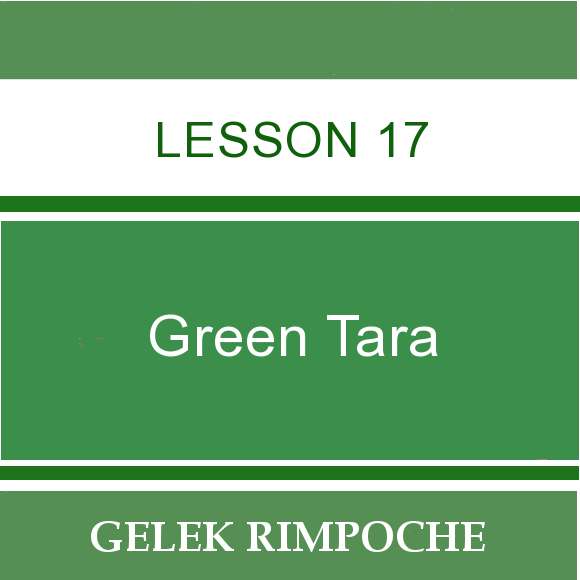
Green Tara – Lesson 17
Lesson Number 17 of 19
(The 21 praises and benefits are recited in English.) After a brief review of earlier sessions, Rimpoche continues his teaching by examining the more wrathful aspects of Tara. The roaring sound of the mantra “ture” and her slightly wrathful hand gesture overpower all evils including those that are the most difficult to tame — our own negative emotions. These include the direct afflictive emotions as well as those negative karmic imprints that are embedded more deeply and which represent the most serious obstacle to total enlightenment. (21:55)
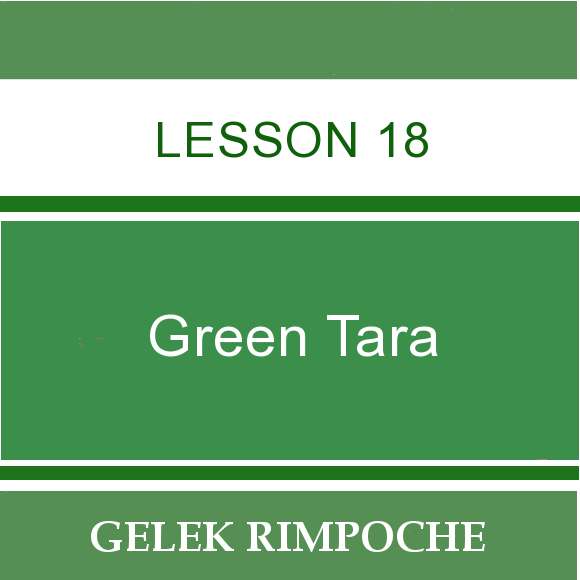
Green Tara – Lesson 18
Lesson Number 18 of 19
The continuing homage verses describe the various aspects of Tara’s appearance and activities — hand mudra, radiant crown, pure laughter, peaceful and wrathful facial expression, earth-pounding feet, garland of flames, vibrant Hum at heart level, etc. — that are focused on defeating both external and internal enemies. (16:52)
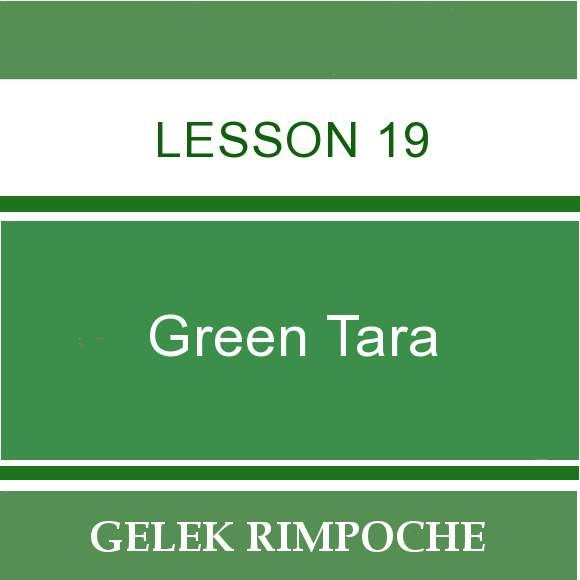
Green Tara – Lesson 19
Lesson Number 19 of 19
Wrapping up the retreat, Rimpoche provides brief commentaries on the final homage verses, which describe Tara’s ability to bestow liberation, dispel all poisons, soothe quarrels and nightmares, quell epidemics and crush the masses of evil influences. (20:00)

